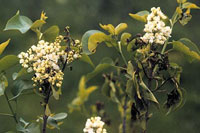Pseudomonas syringae pathovar (pv.) Syringae
Hosts
Lilac, less common hosts include dogwood, chokecherry, poplar, maple and rose
Distribution and Disease Cycle

Photo credit: Oregon State University Extension "An Online Guide to Plant Disease Control "http://plant-disease.ippc.orst.edu/ShowDisease.aspx?RecordID=688
Bacterial blight is a bacterial disease often associated with stressed or wounded plants. It is caused by Pseudomonas syringae pv. syringae, a bacterial pathogen which can overwinter in infected stems, fallen leaves, the soil surrounding infected plants, or on the surface of healthy plants. Rainy spring weather favours disease development, with the bacterium spreading by pruning tools, insect vectors, wind or rain and infecting tissue through wounds or natural openings in leaf or stem tissue (for example, stomata).
Symptoms and Signs
Leaf and stem infections begin as brown spots, often with yellow halos which eventually turn black, enlarging to deform leaves and girdle stems, often leading to premature leaf drop. As the disease spreads, young shoots will wilt and turn black. Flowers and buds may also become infected and killed by early spring infections.
Control

Photo credit: Iowa State University Plant Disease Clinic
If practical, prune infected shoots back to healthy tissue as soon as the disease symptoms appear, disinfecting pruning tools after every cut to prevent further spread of the bacterium. Chemical control may be achieved with applications of fungicides containing copper oxychloride applied as per label instructions. Effective control may be achieved by applying one application in fall at leaf drop (before fall rains) and then multiple applications in spring beginning at bud burst, and continuing every 7 to 10 days during shoot elongation. Apply all chemicals as per label instructions for the specific host plant.